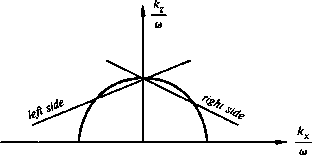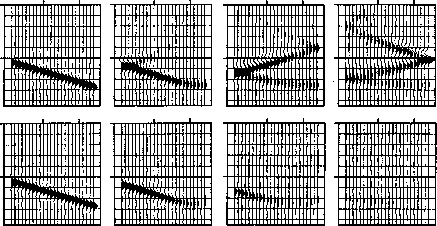In data processing an extrapolation equation is used in the interior of the region under study. This is unlike forward modeling, in which the full scalar wave equation is used in the interior and an extrapolation equation can be used on the boundary. The scalar wave equation has a circular dispersion relation, whereas the extrapolation equation has, ideally, a semicircular one. Reasoning by analogy, Engquist speculated that a quarter-circular dispersion relation might be an ideal side boundary for wave-extrapolation problems. To make his idea more specific and immediately applicable, he proposed that the quarter-circle be approximated by a straight line. This is shown in Figure 2.
The advantage of the straight-line dispersion relation is that in the space domain it is represented by a simple, first-order, differential equation. A first-order equation has first derivatives that can be expressed over just two data points, and thus it can be used as a conventional, two-point, side-boundary condition. The right-side equation in Figure 2 defines the boundary dispersion relation D:
| |
(1) |
 |
In (t,x,z)-space this equation is
| |
(2) |
For a mathematical, nonphysical point of view, imagine some peculiar physics which prescribe that the physical equation that applies in some region is just the equation which has the dispersion relation of the absorbing side condition. Beside this fictitious region imagine another in which the usual extrapolation equation applies. At the point of contact between the regions the solutions would match. It may come as no great surprise that the smallest boundary reflections would occur where the two dispersion relations were a good match to each other. So the slope of the straight line would be selected to form a good fit over the range of angles of interest. An example of side-boundary absorption during migration is shown in Figure 3.
 |